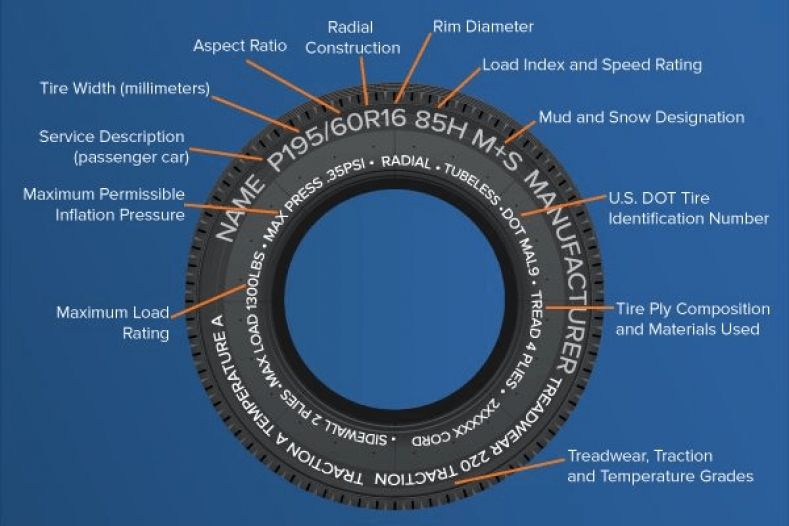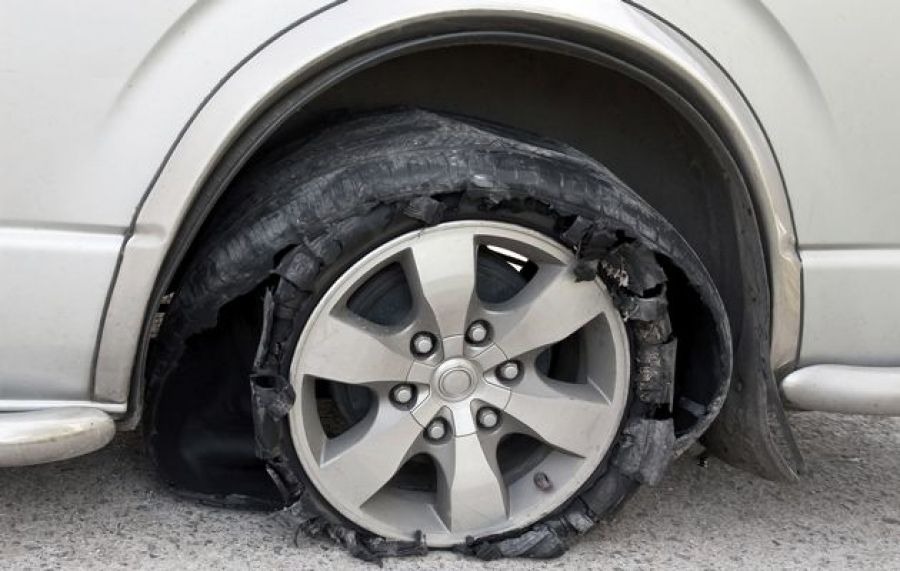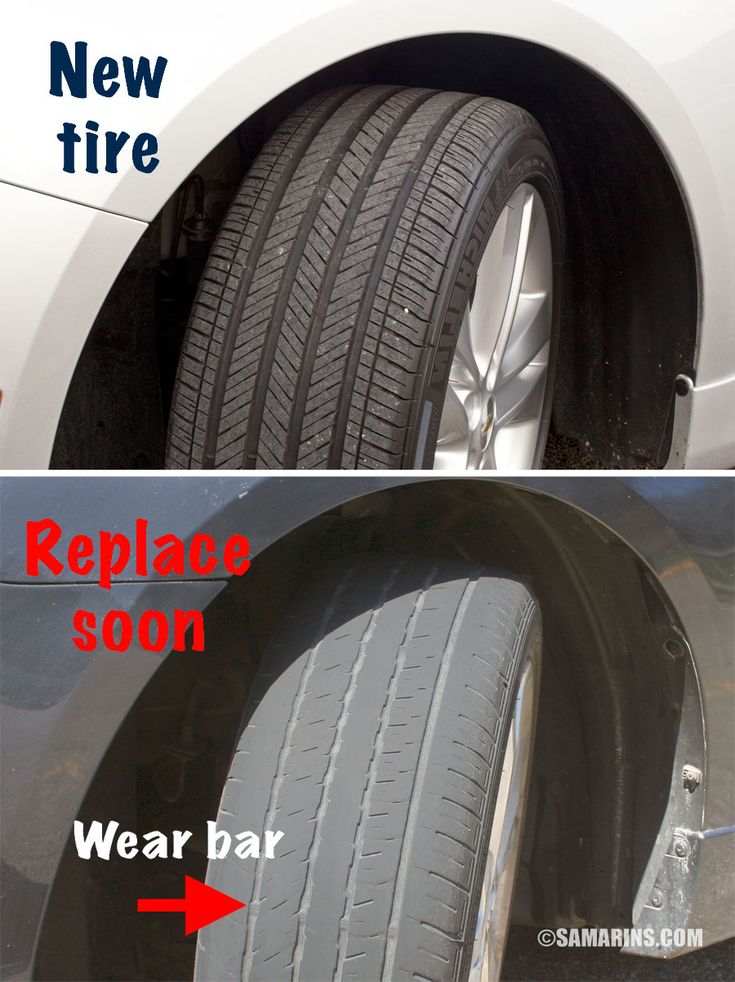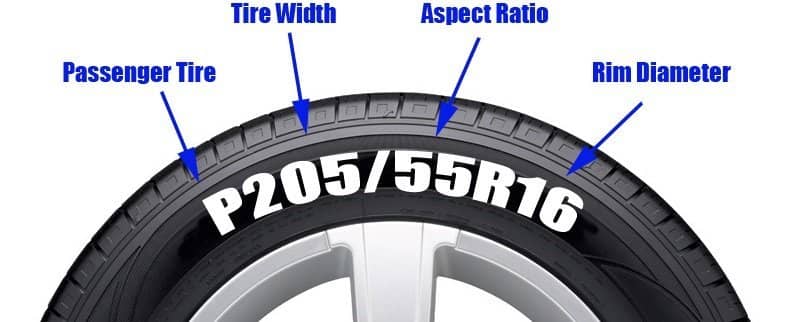Hide Show
Our Showroom Is OPEN— No Appointment Necessary, Walk-Ins Welcome!
Having good winter tires is crucial during the winter season in Nova Scotia. Whether you're driving on snow, slush, or cold, dry pavement, you want to be sure that your vehicle maintains peak traction levels at all times. A key factor in this is making sure that your winter tires still have the tread depth required to grip the road.
My vehicle has 4-wheel drive, so I don't need winter tires.
Even if your vehicle is equipped with 4-wheel drive, you should still have winter grade tires put on your vehicle. 4x4 only aids in accelerating and maneuvering, and is therefore not a substitute for the traction provided by winter tires. Winter tires also have a reduced risk of puncturing, and have specially designed tread patterns to push water away to help you avoid hydroplaning on wet roads.
If your winter tires have tire tread wear indicators built in, then knowing if you need to replace them can be as simple as checking the indicators. The tire tread indicators are the small raised bars, usually 6 on a tire, located along the inside of the tread grooves. They indicate the minimum tread depth permitted. Once the indicators begin to wear, the tires need to be replaced immediately.
Checking the depth of your tire tread doesn't require the use of fancy tools. It can be as simple as taking an ordinary toonie and sticking it upright in the shallowest groove in your tires, and seeing how much of the coin remains uncovered.

A tire tread gauge is a useful tool to keep in your glove compartment, and can be purchased in any hardware or home improvement stores. To use, simply find the shallowest groove in the tire tread, and insert the pin into it, while pushing the base flush with the tire.
 The tires are bald and are not safe for winter driving.
The tires are bald and are not safe for winter driving.Though uncommon, there are some brands of all-weather tires designed for year-long use that have the winter tire symbol. These tires usually have an extra marking on the tread of the tire that acts as an indicator. Once this indicator has worn off, it means the tread is no longer at a depth that is required for safe winter driving, and that they need replacing.
Not all winter tires will wear at the same speed, under the same conditions. For example, winter tires designed for icy conditions tend to wear out faster than tires designed for snow. There are many factors that can affect the lifespan of your winter tires, but making sure that you properly care for your tires can help extend it.
 Tire pressure should be checked at least once a month, or, if you rack up a lot of mileage on a regular basis, once a week.
Tire pressure should be checked at least once a month, or, if you rack up a lot of mileage on a regular basis, once a week.A tire marked with M+S means it has some capability in winter driving, in comparison to summer tires, but the testing to earn this mark only includes driving on packed snow and mud, and does not include measuring traction on ice, slush or cold, dry roads. This means tires bearing this symbol are not equipped to handle the full force of our Nova Scotia winters.
Only tires marked with the winter tire symbol (3 peak mountain and a snowflake) are true winter tires, that have been tested for snow traction and winter driving at temperatures below +7°Celsius.
Our certified technicians are here to fulfill all your vehicle needs. We can check over your tires, and give you a recommendation personalized to fit you. Schedule an appointment today.
The type of tires you have on your vehicle affects where they are moved during a rotation service. If you have directional tires, then the tires must be switched with the tire on the same side (ex: front left tire switched with rear left tire and vice versa). If you have non-directional tires, then the tires must be rotated in an "X" pattern (ex: front left tire switched with rear right tire and vice versa).
We believe in customer service first, so you will never feel pushed or pressured into a purchase. Instead, we will provide you with all the options and information necessary for you to make an educated decision. We have a strong and committed sales staff that works diligently to guarantee that you enjoy your entire purchasing experience. Our knowledgeable business manager can assist you in the leasing or financing process, and keep you informed on warranties and insurance. The dealership is supported by a team of managers who work daily to ensure we are price leaders in the local market, and that customers near and far are satisfied.
Our knowledgeable business manager can assist you in the leasing or financing process, and keep you informed on warranties and insurance. The dealership is supported by a team of managers who work daily to ensure we are price leaders in the local market, and that customers near and far are satisfied.
By Tom Krishner, The Associated Press
It’s time to get some traction.
At any time now, snow could fall over a broad swath of America, and that means your tires need to be checked.
Experts say if the rubber is worn, you could slide, crash or get stuck, even in a light snowfall. Depending on where you live and how badly you need to get someplace in bad weather, you might want winter tires. All-season tires might be an option, but they won’t start and stop as well in ice and snow.
Experts say late October is a good time to shop for tires and get them installed so you’re ready. Here’s how to figure out whether you need new tires and tips from experts on what kind of rubber to buy:
Here’s how to figure out whether you need new tires and tips from experts on what kind of rubber to buy:
Check the tread depth: Stick a quarter into the tire grooves at several spots with George Washington’s head upside down. If you can see the top of Washington’s hair, you have 4/32 of an inch of tread or less. That means it’s about time to replace your tires. You may have a little time left in warm, dry weather, but tires with less than 4/32 won’t grip well in ice and snow. People used to use a penny to check tread depth. But if the top of Abraham Lincoln’s head can be seen, that means you’ve only got 2/32 inches of tread left. “At that point most tires are basically worn out and need to be replaced immediately,” says Gene Petersen, tire program manager for Consumer Reports, which does extensive tire testing.
Winter or all-season? It depends on where you live, how urgently you need to be somewhere in the snow, and whether your vehicle is 2-wheel-drive or all-wheel-drive. In an area with moderate snowfall, you probably can get by with all-season tires, especially if you can wait for plows to clear roads before going anywhere. Generally, if you live south of Cincinnati, Ohio, then all-season tires should work, says Woody Rogers, director of tire information for Tire Rack, an online tire store in South Bend, Ind. But to the north, where heavy snowfall is more likely, winter tires will be better. If the engine powers all four of your wheels, good all-season tires may suffice. Generally, winter tires on a two-wheel-drive vehicle grip better than all-season tires on a four-wheel-drive vehicle. Experts say all-wheel-drive makes a big difference starting off in snow. But it won’t help you stop in snow. That’s where winter tires come in. They’ll stop faster in slippery conditions because they grip ice and snow better due to specially designed soft tread compounds. In bad weather, winter tires grip almost like they’re being driven on dry roads, says John DiPiazza, part owner of A&A Tires in Milwaukee.
In an area with moderate snowfall, you probably can get by with all-season tires, especially if you can wait for plows to clear roads before going anywhere. Generally, if you live south of Cincinnati, Ohio, then all-season tires should work, says Woody Rogers, director of tire information for Tire Rack, an online tire store in South Bend, Ind. But to the north, where heavy snowfall is more likely, winter tires will be better. If the engine powers all four of your wheels, good all-season tires may suffice. Generally, winter tires on a two-wheel-drive vehicle grip better than all-season tires on a four-wheel-drive vehicle. Experts say all-wheel-drive makes a big difference starting off in snow. But it won’t help you stop in snow. That’s where winter tires come in. They’ll stop faster in slippery conditions because they grip ice and snow better due to specially designed soft tread compounds. In bad weather, winter tires grip almost like they’re being driven on dry roads, says John DiPiazza, part owner of A&A Tires in Milwaukee. “It’s quite amazing,” he says.
“It’s quite amazing,” he says.
Read the reviews: If you decide to go with all-season tires, make sure you read test reports and consumer ratings. All-season tires vary wildly in their ability to grip snow, says Rogers, whose store also does tire testing. “The gap from good to bad is staggering,” he says. DiPiazza says you should stick to well-known brands for the best performance. If you choose winter tires, also read reviews. Tire Rack’s tests show less of a variance between snow tires from different brands. Deeper grooves generally mean more snow traction, but you can’t always tell performance from looking at a tire, Petersen says. Although winter tires have improved, they still compromise dry-pavement handling for snow and ice performance.
Replace all four tires: Putting snow tires on just the two drive wheels can make your car difficult to handle in snow and ice. When two wheels on one axle grip better than the other two, it creates a handling imbalance that could be treacherous if you’re trying to stop quickly or steer around something. “Those are the situations where you need your car to work best, an emergency situation,” says Rogers.
“Those are the situations where you need your car to work best, an emergency situation,” says Rogers.
The price: Snow and all-season tires generally cost about the same. Consumer Reports found that sedan tires average around $145 each. SUV tires average $178 apiece. Shopping around could get you a better deal. Make sure the price includes mounting and balancing.
Buy early: Experts say now is the time to buy, when there’s time to do research and there’s an abundant selection of snow or all-season tires. If you wait until the first snowfall, you might get stuck with what the dealer has on hand in the size that fits your car. But don’t buy too soon: DiPiazza recommends installing winter tires when the daily high temperature is generally below 50 degrees.
Before the next winter, motorists who have driven for several seasons on studded or friction tires have a question. Should I buy new ones or old ones are still able to provide reliable grip on snow and ice? To make the right decision, you need to know how to determine the wear of winter tires, and what is its maximum allowable limit.
The main indicator of the suitability of tires for operation is the tread height. However, in the case of studded tires, the number of studs is an equally important factor. Even when there are almost none left, some motorists are in no hurry to get a new thing. Such drivers mistakenly think that in this way their tires have become frictional.
But tires, which are popularly called Velcro, have a completely different rubber compound. They are much softer than studded ones and lose their valuable properties faster in the cold.
Winter tire wear is estimated according to the following indicators:
The "List of malfunctions and conditions under which the operation of vehicles is prohibited" establishes a critical tread wear of a winter tire - 0. 4 cm. But most manufacturers of studded and friction tires recommend changing earlier. To measure the tread height, a regular ruler will do. If the result is 0.5 cm, it is better to purchase new tires.
4 cm. But most manufacturers of studded and friction tires recommend changing earlier. To measure the tread height, a regular ruler will do. If the result is 0.5 cm, it is better to purchase new tires.
It is necessary to measure the tread height not in one place, but in several, since wear can be uneven. For example, 0.6 cm may remain on one side of the tire, and 0.4 cm on the other. In this case, it is necessary to change the tires. You can buy winter tires at the TopDetal.ru online spare parts store at competitive prices.
If the tread height is normal, this does not mean that the tire is serviceable. It is extremely important that she does not have hernias.
The presence of swelling on the sidewall directly threatens safety. If such a tire falls into a hole with sharp edges at speed, it may burst and the car will become uncontrollable.
You also need to understand that rubber loses its properties over time. She starts to twang. On tires, even if they are not in use, microcracks may appear. In other words, the product has an expiration date, after which it is necessary to replace it, even if the winter tire tread wear is very small.
On tires, even if they are not in use, microcracks may appear. In other words, the product has an expiration date, after which it is necessary to replace it, even if the winter tire tread wear is very small.
Most manufacturers recommend not using tires for more than five years. Approximately over this time, they lose their original properties necessary for reliable adhesion to the road.
Fresh number
RG-News
Rodina
thematic applications
Union
Fresh number
Rubrication:
Passenger car
Viktoria Chernysheva
Soon it's time to "change shoes" for cars, and therefore many motorists are inspecting winter tires. Many people think that the "fatigue" of a tire should be determined solely by the wear of the tread pattern and the number of studs. However, experts say that tire performance also depends on the aging of the rubber compound. Its main destroyers are chemicals poured on roads in tons, fuels and lubricants, as well as the sun's rays.
However, experts say that tire performance also depends on the aging of the rubber compound. Its main destroyers are chemicals poured on roads in tons, fuels and lubricants, as well as the sun's rays.
Konstantin Chalabov / RIA Novosti
Reagents, washer fluid and oil from passing trucks soak into tires and damage the rubber compound. This leads to a loss of its elasticity. Cracks that form on tires become a place of increased wear, where chemicals penetrate. The destruction begins to go even stronger, aggressive substances reach the inner layers of the tire. As a result, the cord threads are torn. And then the chemicals get to the metal threads of the frame, which eventually also become unusable.
To this we can add the impact of other factors - solar radiation, physical wear, and so on. Over time, tires lose their former strength and coefficient of adhesion to the surface. It becomes unsafe to ride them.
According to Aif.ru, tire manufacturers usually limit the life of tires to 5-6 years. Some companies (such as Michelin and Nokian) guarantee safe driving for 10 years. However, it must be borne in mind that the date of manufacture of the rubber is considered not the date of sale, but the date of its manufacture. A tire that has been in storage for a year is no longer considered new, and the longer it is stored, the worse its performance becomes.
Some companies (such as Michelin and Nokian) guarantee safe driving for 10 years. However, it must be borne in mind that the date of manufacture of the rubber is considered not the date of sale, but the date of its manufacture. A tire that has been in storage for a year is no longer considered new, and the longer it is stored, the worse its performance becomes.
What do experts advise to pay special attention to?
First of all, if a tire has been damaged (cut or punctured), then it should not be ridden for more than two years.
Second - you need to monitor the tread depth. For winter tires, it exceeds 10-12 millimeters; the tires also have lamellas that provide a sticking effect. With active use, they quickly lose part of the material. If the tread is noticeably worn, the rubber should be replaced without waiting for the expiration of the service life declared by the manufacturer.
In general, a winter tire without extreme loads can last up to six seasons.